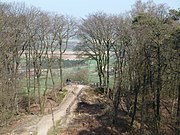Duivelsberg
| Duivelsberg | |
|---|---|
| Wylerberg | |
 | |
| Highest point | |
| Elevation | 75.9 metres |
| Coordinates | 51°49′13″N 5°56′37″E / 51.820192°N 5.943666°E |
| Geography | |
Duivelsberg (
annexed from Germany
and retained after World War II.
Location
The 75.9-metre (249 ft) hill is located on a moraine east of
Beek and the Dutch-German border. The nature reserve covers about 125 hectares (310 acres) and is predominantly covered with deciduous trees, especially chestnut. It is managed by the Staatsbosbeheer, the Dutch Forestry Commission.[1]
History
Over the centuries the hill has been militarily significant, this historical background in more recent times having given rise to issues of sovereignty between
The Netherlands
.
Military history from the Middle Ages until World War Two
In the Middle Ages
508th Parachute Infantry Regiment[2] fought to capture the Duivelsberg, "Hill 75.9",[3] during Operation Market Garden.[4]
Annexation issues
Until 1949, the hill was part of the nearby German village of Wyler in the municipality of
annexed from Germany on 23 April 1949. Unlike the other areas, Duivelsberg was not returned to the German authorities on 1 August 1963 and remained Dutch territory.[5] The Nijmegen-born politician Marinus van der Goes van Naters, who also lived in nearby Nijmegen during the negotiations with Germany, successfully urged that the nature reserve be kept Dutch.[6]
Ownership & Conservation
The Duivelsberg was inherited in 1906 by Marie Schuster-Hiby who, between 1921 and 1924, built an expressionist villa designed by the German architect Otto Bartning. In 1965, the Schuster-Hiby family sold the villa to the Dutch State. Since 1985, the Huis Wylerberg has been a nationally-protected building in which conservation organisations are located.[7]
-
Huis Wylerberg
-
Castle Hill
-
View from the hilltop with Germany in background
See also
References
- ^ [1] Archived 2015-02-11 at the Wayback Machine Wandelroute Duivelsberg Rijk van Nijmegen 3 km. Staatsbosbeheer
- ISBN 978-0850527858. Retrieved 2015-02-11.
- LCCN 62-60001. Archived from the originalon 2016-03-04. Retrieved 2015-02-11.
- ^ ""De Duivelsberg in September 1944/2014: Venue for symposium and public event" | Market Garden 70". Archived from the original on 2015-02-11. Retrieved 2015-02-11. De Duivelsberg in September 1944/2014: venue for symposium and public event. Berg en Dal, 11 September 2014
- ^ (German: Vertrag vom 8. April 1960 zwischen der Bundesrepublik Deutschland und dem Königreich der Niederlande zur Regelung von Grenzfragen und anderen zwischen beiden Ländern bestehenden Problemen; short: Ausgleichsvertrag, i.e. treaty of settlement. Bundesgesetzblatt (Federal Law Gazette), part III, no. 181-1.
- Nederlandse Publieke Omroep (organization)
- ^ [3] Archived 2015-02-11 at the Wayback Machine De Duivelsberg als grensgeval. GSRO




